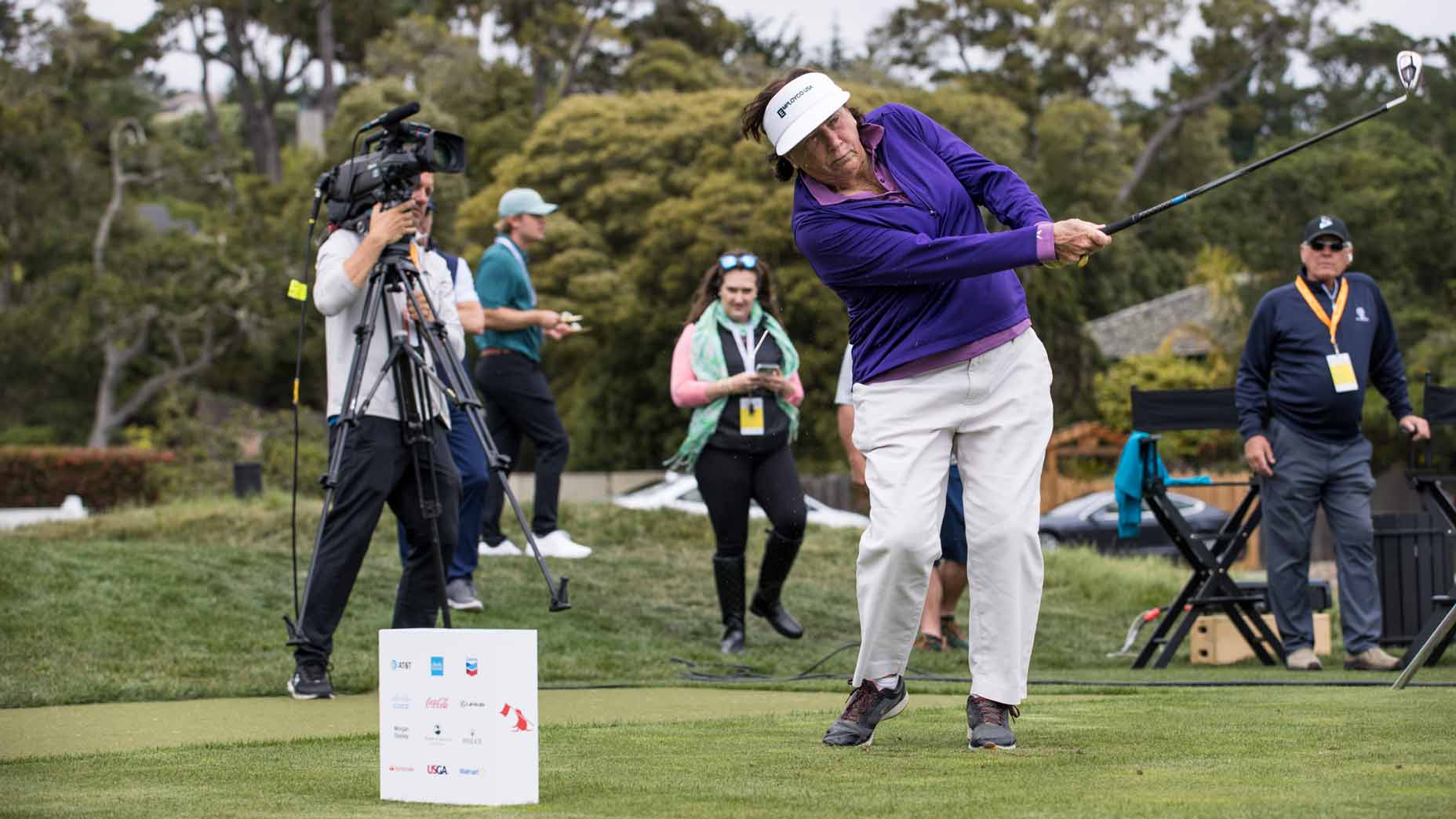It’s Thursday morning and the golf is on.
There’s always golf one can put on, these days. The DP World Tour was on Golf Channel early this morning, beaming in from Denmark. The PGA Tour was on a few hours after that, cameras in Illinois streaming the action to your iPads via ESPN+ and eventually on Golf Channel, too. Tomorrow you can add LIV Golf to your listings, on the CW. There’s more golf than you can shake a titanium stick at.
Every week, inevitably, there’s a hierarchy of events. You might build it subconsciously but you build it nonetheless, unofficially ordering tournaments, first to last, by the amount they matter. Your hierarchy may be different than mine (happy 4th, let’s celebrate our freedoms) but this week I’ve got a clear No. 1, because I’ve been eager to watch the U.S. Women’s Open at Pebble Beach since the day it was announced. The biggest event in the women’s game is made bigger by this week’s venue, which has never hosted a women’s major but has hosted men’s majors seven times (plus the PGA Tour every winter). Should it have taken this long to get female pros competing here? Of course not! But it’s nice to have them now anyway.
The event is made greater by a golf course, which I — like Nelly Korda — got to know from television and from Tiger Woods PGA Tour 2005. It’s made greater by the money, too. Cash isn’t the only thing that signifies import nor significance in professional golf, but the latter certainly seems to follow the former, so it’s significant that the USGA is doling out $11 million this year, up from $10m last year.
The 2022 champ, Minjee Lee, said at the champions dinner on Tuesday night that attendees were comparing notes on first-place checks. Fifty years ago the first-place check exceeded $5,000 for the first time. Forty years ago the winner cracked $25,000. Thirty years ago she’d climbed over $100,000. The first time Annika Sorenstam (who’s in this week’s field) won was in 1995; she earned $175,000. The last Aussie to win, Karrie Webb, took home $500,000 in her maiden victory in 2000. Lee? She took home $1.8 million last summer.
For me, it’s the music. The significance, that is — it begins with the music. “In Celebration of Man,” the bright, regal theme of USGA events on NBC properties, returned to the event in 2020 when the USGA returned to NBC after the event’s half-decade under the Fox umbrella. The theme originates with Yanni, the mononymous Greek composer, and as it kicks off coverage I can feel in my soul that this is important. The trumpets have told me so. The theme connects me to U.S. Opens gone by, to TV intros watched from the floor of my grandparents’ living room, to childhood mornings spent tiptoeing to the basement to flip on the Open Championship at 6 a.m. I’m fairly sure Yanni’s theme wasn’t even on The Open intros then, but when I revisit that scene in my mind’s eye, that’s the music that plays. I’m a sucker for both branding and nostalgia, so I hear the music and memories come flooding back and simple joys do, too.
Peacock didn’t exist then, nor did the Fire TV stick. But now the latter has brought the former onto my television in remarkably high definition. Yanni’s there, too, ushering in the morning’s featured group. It’s a proud production. The golfers, though, are struggling.
Jin Young Ko is No. 1 in the world and among the tournament favorites. But she just bogeyed No. 10 and No. 12 and No. 14 and No. 16, a neat every-other pattern on her scorecard but a decidedly disappointing set of numbers to record. A double-cross leads to double bogey at 17, ruining the pattern and worsening the numbers, too. The announcers keep saying things like, “and Jin Young Ko is currently beating just one player.” This is surprising and it is not good.
Nelly Korda is No. 2 in the world, also among the tournament favorites and also struggling. She’s a Florida girl by nurture and nature and admittedly averse to the cold. It’s cold this morning and she starts cold, missing wide right with her tee shot at No. 10 and opening with double bogey. She bogeys the odd holes — 13, 15, 17 — looking colder with each missed par putt. An impressive up-and-down for birdie at No. 18 stops the bleeding and salvages a four-over-par first nine. The next nine goes better, which means four over is also where she’ll finish the day, just inside the top 100.
The best of the group is the least heralded: Lexi Thompson. It’s odd to refer to her as least heralded because for so many years she was front and center, at this event and many others. But she hasn’t cracked the top 20 in five LPGA starts this season, which means the sportsbooks don’t think much of her chances. She’s not short on experience, though: Thompson is just 28 but this is somehow her 17th of these. In those first 16 she’s logged eight top 10s and two podium finishes — just no wins as of yet.
Thompson doesn’t look wholly comfortable with long drives nor with short putts but her baseline of golf is still so high that she’s hanging tough, yielding to a bogey but bouncing back with a birdie and so on. A plugged lie leads to double at No. 1. Agh. A sensational second leads to a five-footer for eagle at No. 6. Ooh. She misses that, settling for birdie. Agh, again. She shoots two-over 74, a number that’ll still prove better than field average.
The greens looks firm. They look green, too, but undoubtedly firm. As a result they’re difficult to hold, so some of the world’s best golfers keep hitting approaches that land on but scoot off. Even wedges from the fairway skip forward and then trickle to a stop; there’s very little sign of balls screeching to a halt, the way they might elsewhere. This makes some of the small greens play even smaller. Miss the fairway? Good luck holding anything. Even par seems like it’ll be a good score all week.
How different is this U.S. Women’s Open? Ask a past champBy: Josh Sens
Elsewhere on the course it’s Xiyu “Janet” Lin who posts 68, even with a bogey at her final hole. Irish amateur Áine Donegan is right behind her at 69, thanks to five birdies and an eagle. USA Network picks up the action, which requires a little deft button-pushing on the Fire Stick. I’m up to the challenge.
The broadcast is a mix of beginnings and endings. It’s a celebration of what’s been and what might yet be. There’s Sorenstam, whose 80 was just a shot behind the World No. 1 but ahead of fewer golfers than she’d wished. Michelle Wie West is playing her final event and celebrating the ninth anniversary of her lone major win. But a snowman 8 at the par-5 18th undoes her; she shoots 79 by way of “really stupid, rusty bogeys.” She’s been scooping too many gimmes in practice, she admits. Putting ’em all out is decidedly unpleasant. She hits it well, by her description, and shoots 79. Out here, discomfort is doom.
It’s afternoon now, and the golf is on. I just mentioned some endings but there are beginnings, too, not just for Donegan but for Rose Zhang, who is playing her first Women’s Open as a professional. Expectations are silly high after a win and a major-championship top 10 in her first two professional starts; she’s the betting favorite. Maybe she should be — she does own the course record here, after all.
Zhang birdies No. 3 and then No. 4, too, and things begin to look very simple. They look suddenly more complex for her playing partner Lydia Ko, who was No. 1 in the world just a few months ago but hasn’t quite been herself of late. She’s one under par through four but suddenly smother-hooks an iron way left at No. 5 — like, 40 or 50 yards left — and struggles her way to a quadruple-bogey 7. She birdies the next, naturally.
Hyo Joo Kim comes on screen and her golf swing looks like it could never produce an off-line tee shot, except then it does, because that’s what golf swings do. Zhang, too, proves fallible, losing a ball down the cliff at No. 8 en route to double.
There’s a fist pump, suddenly, from Emilia Migliaccio, who cans a 20-footer for birdie putt at No. 11. She’s a Wake Forest grad doing improbable double duty this week; she walked with the morning trio of Ko, Korda and Thompson and teed it up just after they finished their rounds. Nice work, if you can get it.
Aussie Hannah Green throws an Airpod in, sliding seamlessly into interview mode while walking the par-4 9th and chatting to the broadcast crew. She’ll make bogey there, a reasonable feat considering it’s playing as the second-toughest hole of the day, averaging over 4.4 strokes. These remote walk-and-talks would have been unthinkable a few years ago. They’re standard fare now. Fire Sticks are, too.
I’d planned to be there in person, to cover the event live, to see Pebble and these golfers on it. Earlier this year I spoke with LPGA commissioner Mollie Marcoux Samaan about her vision for women’s events; she talked about them feeling big. How would that look and feel? I got sick; I couldn’t go. So here I am, watching from my couch. I’m realizing it’s not a bad spot to be.
We’ve entered primetime viewing back on the East Coast by now. The broadcast cuts to a scenic aerial and then a look at the leaderboard, blue against the green backdrop. In Celebration of Man trumpets through the TV speakers. It’s a good night for the golf to be on.
It feels big.
The author (cautiously) welcomes your comments at dylan_dethier@golf.com.











